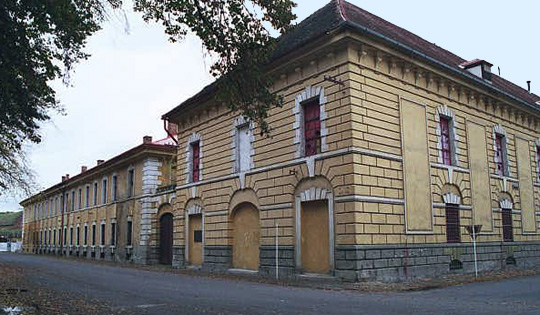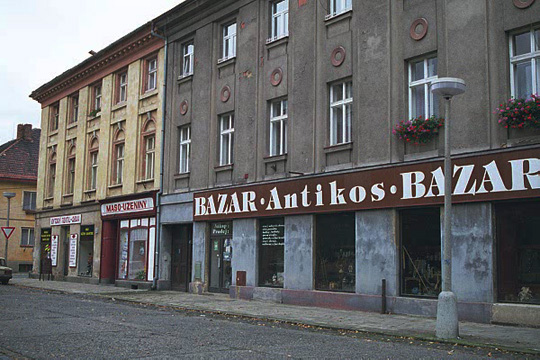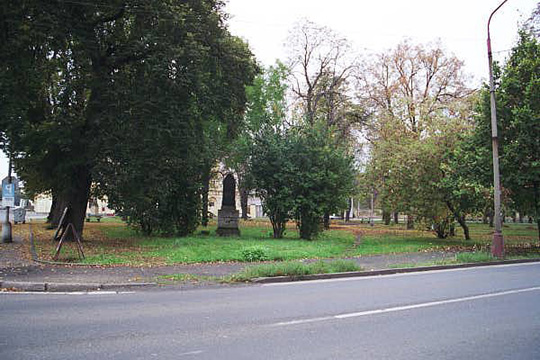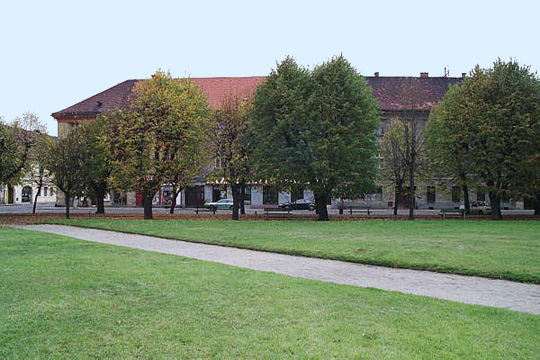Famous Red Cross Visit to Theresienstadt

Bodenbach barracks
built in 1792 in Theresienstadt
Among the Nazi concentration camps, Buchenwald
is famous for its human lamp shades; Auschwitz is noted for its
gas chambers and Bergen-Belsen will be forever remembered as
the place where British bulldozers shoved the emaciated corpses
of the deliberately starved inmates into mass graves. Theresienstadt's
claim to fame is the Verschönerung, the beautification program
in which the Nazis cleaned up the ghetto in preparation for a
visit on June 23, 1944 by two Swiss delegates of the International
Red Cross and two representatives of the government of Denmark.
The Nazis began their beautification
program in late 1943 in preparation for the inspection, demanded
by the Danish King Christian X, which was more than six months
away. Especially because the Theresienstadt ghetto was the home
of many prominent and well known Jews, the Nazis wanted to fool
the world into thinking that the Jews were being well treated.
The famous Red Cross visit to Theresienstadt
came about because the government of Denmark was anxious to know
about the conditions of the ghetto since 466 Danish Jews had
been sent there, beginning on October 5, 1943. Because of pressure
brought to bear on the Germans by the Danish government, the
Danish Jews received preferential treatment in the ghetto. They
were sent back to Denmark on April 15, 1945, under the supervision
of the Red Cross, three weeks before the ghetto was liberated
by Soviet troops on May 8, 1945. Thus they escaped the typhus
epidemic which devastated Theresienstadt in the last weeks of
the war.
During World War II, information about
the mistreatment and gassing of the Jews was known throughout
Europe and the United States. Anne Frank in her attic and elementary
school children in America had heard about the gassing of the
Jews as early as June 1942. News of the gassing and other horrors
in the concentration camps was broadcast on the radio by the
British throughout the war.
The inmates of the Theresienstadt ghetto
learned that the gassing stories were really true when a transport
of 1,200 orphan children arrived from the Bialystok ghetto; upon
being sent to a large shower room immediately after their arrival,
the children became hysterical because they had heard the stories
about the gassing of the Jews and assumed they were being put
into a gas chamber disguised as a shower room.
On December 18, 1942, twelve allied governments,
including the Czech government in exile in England, denounced
the Germans for their treatment of the Jews. Possibly due to
these complaints, Heinrich Himmler, the head of the Nazi concentration
camp system, issued an order on February 2, 1943 to stop the
transports from Theresienstadt to the death camp at Auschwitz.
At that time the total number of prisoners housed at Theresienstadt
was 44,672. The transports to Auschwitz stopped for seven months.
 Half the buildings
in Theresienstadt needed more beautification in 2000
Half the buildings
in Theresienstadt needed more beautification in 2000
The visit to Theresienstadt by the Red
Cross was by no means the only visit to a Nazi camp, but it is
the one that is the most written about because the Nazis used
the occasion to disseminate propaganda by presenting the ghetto
in a most favorable light. But even before the famous visit,
the Germans had been honoring the 1929 Geneva Convention which
required them to allow the Red Cross to provide packages to the
concentration camps.
The Red Cross was aware of the camps
from the beginning of the war and they began sending packages
to the inmates of the major Nazi concentration camps, starting
in August 1942; by February 1943 the Red Cross was sending packages
to all the Nazi concentration camps. From the Autumn of 1943
to May 1945, the Red Cross distributed 1,112,000 packages containing
4,500 tons of food to the Nazi concentration camps, including
the Theresienstadt ghetto and the Auschwitz death camp. In addition,
the Nazis allowed packages to be sent to the concentration camp
prisoners from friends and relatives outside the camps.
In recent years, the International Red
Cross has been severely criticized for giving the Nazis good
reports after their inspections; they even praised the Nazis
for their diligence in delivering the Red Cross packages despite
the hardships of the war.
According to the Red Cross statistics,
99% of the American Prisoners of War in the German POW camps
returned home after the war, due largely to the packages containing
food and typhus vaccine which were delivered from America by
the Red Cross right up to the end of the war.
The Soviet Union did not allow the Red
Cross in any of their camps during the war because they had not
signed the 1929 Geneva convention and they were not required
to open their gulags (concentration camps) or Prisoner of War
camps for inspection.
After the war, General Dwight Eisenhower
signed a one-sentence order on August 4, 1945 which read "Effective
immediately all members of the German forces held in US custody
in the American zone of occupation in GERMANY will be considered
as disarmed enemy forces and not as having the status of prisoners
of war." The DEF status meant that the German soldiers who
had surrendered would not be entitled to protection under the
Geneva convention: no Red Cross inspections were allowed in the
US prison camps after the war and Red Cross parcels for the defeated
Germans were banned by the US War Department.
Even before the December 18, 1942 complaint
by 12 allied governments, the Nazis had already turned the Theresienstadt
ghetto into a propaganda tool to fool the rest of the world about
their plans to exterminate all the Jews in Europe.
On Sept. 13, 1942, the Nazis had opened
shops in Theresienstadt where the Jews could buy second-hand
clothing and other goods. Eventually 8 such shops were opened.
On Dec. 8, 1942, the Nazis had opened
a cafe, facing the main square in Theresienstadt, where the Jewish
inmates could meet to socialize and listen to music.
The photograph below shows Neuegasse,
the street where the Cafe and ghetto shops were located. On the
left is the building where there was a store in which the prisoners
could buy used clothing with camp money and the building on the
right is where the Cafe was located. These buildings face the
town square.

Antique Store is now
located where the ghetto Cafe used to be
On May 12, 1943, a bank was opened in
Theresienstadt and camp money was printed to pay the Jews for
their labor in the ghetto factories. This money could be used
at the ghetto cafe or to buy items at the ghetto shops. In order
to give the impression to the outside world that Theresienstadt
was a regular town and not a concentration camp, the Nazis decided
in July 1943 to change the numbers and letters on the streets
and buildings to names, so that any friends or relatives sending
mail to the camp post office would not suspect anything. The
camp name "Ghetto Theresienstadt" was changed to "Jewish
Settlement Theresienstadt."
In the Spring of 1944, the Nazis began
extensive improvements to the ghetto in preparation for the Red
Cross visit. In their mission to impress the IRC delegates, they
outdid themselves, and after the beautification project was completed,
they were so proud of their handiwork that they made a movie
of Theresienstadt entitled "Der Führer schenkt den
Juden eine Stadt" or "The Leader gives the Jews a town
as a gift."
Before the Red Cross visit, the town
square in Theresienstadt had been fenced off and a large circus
tent was erected there in May 1943. Inside the tent, over 1,000
ghetto Jews did factory work in the Kistenproduktion, which was
the making of boxes. After the Red Cross requested an inspection,
factory production was stopped by the end of 1943, and in the
Spring of 1944 the fence and the tent were removed and grass
and flowers were planted in the square. A music pavilion was
built on the south side of the square, just across from the camp
cafe. The cafe and the camp shops were improved for the inspection.
A playground was built for the children
in the Stadt park, across from the present Ghetto Museum building.
The most beautiful park in the town, Brunnen Park, was made public
and the Jews were now allowed to use all four of the parks in
the ghetto.
 Stadt Park where the
Nazis built a playground for the ghetto children
Stadt Park where the
Nazis built a playground for the ghetto children

Brunnen Park in Theresienstadt
On the outskirts of the town, the Sokol
building, formerly used to house Jews who were suffering from
encephalitis, was changed into a social club for cultural events
with a library for the use of the Jews and a Synagogue. A Columbarium
to hold the ashes of the Jews who died in the camp was built
near the crematorium and tombstones were placed on the graves
in the cemetery. The beautiful 18th century barracks buildings
were refurbished and improved inside and out.
With Theresienstadt now beautified, the
next step was to relieve the overcrowding in the ghetto so that
the IRC would not realize the actual inhuman living conditions
there. In September 1943, December 1943 and May 1944, just before
the scheduled visit, there was a total of seven transports on
which 17,517 Jews were sent to the death camp at Auschwitz.
The Czech Jews from these transports
were placed in a "family camp" at the Auschwitz II
camp known as Birkenau. The men, women and children were allowed
to stay together in contrast to the other prisoners at Auschwitz-Birkenau
who had to live in separate fenced-off sections where the men
and women were segregated from each other. The Czech Jews were
allowed to wear civilian clothes instead of the blue and gray
striped prison uniforms that the other inmates had to wear. Most
importantly, they were allowed to send letters back to Theresienstadt
to tell the others about how well they were being treated in
the camp. Six months after it was opened, the "family camp"
was closed and only 1,168 of the Theresienstadt prisoners survived.
The rest are presumed to have perished in the gas chamber.
The Red Cross inspection of the camp
lasted for six hours but the cultural events went on for a week.
During the week of the inspection, there were numerous performances
of the children's opera called Brundibar in the new cultural
hall in the Sokol building.
A jazz band, called the Ghetto Swingers,
played in the music pavilion in the square. This was a real concession
by the Nazis since they had banned jazz or swing music in Germany.
Hitler regarded swing as "degenerate" music because
two of the leading musicians, Benny Goodman and Artie Shaw, were
Jewish.
The Nazi concentration camps typically
had an orchestra which played classical music as the prisoners
marched to work or to the gas chambers. The Germans loved classical
music and Germany was world famous for the cultural contributions
of Beethoven, Bach and Brahms. One could say that the Nazis literally
put down their violins in order to kill the Jews.
 Music pavilion was
built in the town square in front of the cafe
Music pavilion was
built in the town square in front of the cafe
Unfortunately, most of the Theresienstadt
Jews did not live to enjoy their new improved ghetto. In the
fall of 1944, after the June Red Cross visit, the transports
to Auschwitz began again. In Sept. 1944, there were approximately
30,000 prisoners living in Theresienstadt. Eleven transports,
totaling 18,402 inmates of the ghetto, were sent to Auschwitz
between September 28, 1944 and October 28, 1944, the date of
the last transport to be sent to the gas chambers of Auschwitz.
Of the Jews sent to Auschwitz on these eleven transports, there
were only 1,574 survivors. The rest died in the gas chamber,
were worked to death or perished in the typhus epidemics which
were rampant there. After these transports left, the number of
Jews remaining in Theresienstadt was around 11,000, including
819 children under the age of 15.
On February 5, 1945, a transport of 1,200
Jews left Theresienstadt on passenger trains, bound for Switzerland,
a neutral country in the war. Another transport of 623 Jews was
sent to Sweden. By that time, the Germans realized that they
were losing the war and they were trying to fool the Allies into
thinking that they did not have a deliberate plan to kill all
the Jews. It was around this time that the Allies were escalating
their efforts to end the war by bombing German civilians in Nürnberg
on January 2, 1945 and Dresden on February 13,1945. But unlike
the atomic bombs dropped on Hiroshima and Nagasaki in order to
force the Japanese to surrender, the Allied destruction of Germany's
beautiful cities did not deter the Germans in their plan to annihilate
European Jewry.
Three months after their inspection of
Theresienstadt, the Red Cross visited the Auschwitz death camp
in September 1944 but failed to notice that the purported shower
rooms there were really gas chambers. In 1948, the Red Cross
released a three volume report in which the findings on the Auschwitz
visit were included: "Not only the washing places, but installations
for baths, showers and laundry were inspected by the delegates.
They had often to take action to have fixtures made less primitive,
and to get them repaired or enlarged" (Vol.III, p. 594).
Apparently the Red Cross representatives couldn't tell the difference
between the fake shower heads in the gas chambers at Birkenau
and real shower nozzles in a genuine shower room.
On March 5, 1945, Adolf Eichmann visited
Theresienstadt to check out the camp before the next Red Cross
visit which was scheduled for April 6, 1945. By then, there was
complete chaos in Europe in the final days of the war; Theresienstadt
had become shabby again because most of the inmates were elderly
people or young children who were not able to work. Most of the
able-bodied Jews had been sent on the transports to the death
camp at Auschwitz, where there were also factories in which the
Jews were being put to work for the German war effort. Eichmann
ordered the town to be cleaned up again, and the ghetto passed
the second Red Cross inspection with a good report.
Following the second inspection, on April
15, 1945, all the Danish Jews in the ghetto were transported
back to Denmark with the help of the Red Cross. On May 3, 1945,
the Nazis turned the whole Theresienstadt ghetto over to the
Red Cross workers who now had the unpleasant task of trying to
save the survivors from a raging typhus epidemic. Typhus is caused
by body lice, and the Germans had tried unsuccessfully to control
the lice in the death camps in Poland by using Zyklon B, the
same chemical that they used to kill the Jews in the homicidal
gas chambers.
Typhus had been brought into the Theresienstadt
ghetto by 13,454 survivors of the eastern concentration camps
who began arriving after April 20, 1945. Some of them had been
sent to Auschwitz a few months earlier and were now returning.
In the final days of the war, the Theresienstadt ghetto became
a hell hole, where a typhus epidemic was totally raging out of
control, just like the unfortunate Bergen-Belsen camp which the Nazis had voluntarily
turned over to the British on April 15, 1945.
In the end, the whole world learned of
the true story of the Theresienstadt ghetto and the genocide
of the Jews, in spite of the Nazi beautification program, or
maybe because of it.
|